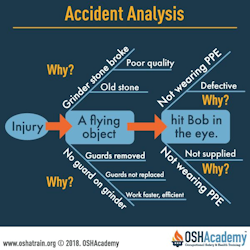Analysis Tools
We've discussed the various phases of accident investigation analysis and now we'll shift gears and talk about the tools you can use.
5-Why Analysis
The 5-Why Analysis is a helpful method to begin your journey towards identifying the root causes of an accident. Let's explore how to perform a 5-Why Analysis of an accident by going through the steps below. Begin with understanding the details of the accident and ask why it occurred. The answer to each "why" question becomes the basis for the next question. Repeating this series of questions and answers at least five times will lead you to a better understanding of the fundamental root cause behind the accident.
| Description of the Accident | ||
| Bob broke his arm when he hit the ground after falling off an extension ladder. | ||
| Question | Answer | |
|---|---|---|
| 1 | Why did Bob fall off the ladder? | Because he lost his balance |
| 2 | Why did Bob lose his balance? | Because the ladder was very unstable |
| 3 | Why did Bob use the defective ladder? | Because it was the only ladder available |
| 4 | Why was it the only ladder available? | Because it was never replaced |
| 5 | Why was the ladder never replaced? | Because management was unaware it was defective |
You'll notice that in most cases, determining the root causes of an accident demands more than just five questions. Moreover, for each of these questions, you're likely to come across several potential answers. Each answer will then lead you down different lines of questioning. It's crucial to keep asking "why" in each of these paths until you reach the core underlying factors that led to the accident. Also, you'll realize that the root causes of accidents often tie back to failures within the safety management system – its structure, inputs, processes, and outputs.
The Fishbone Diagram
You can use the 5-why technique coupled with the cause-effect fishbone diagram to help you discover root causes.
The "fish" should look something like the diagram in the image. The backbone and larger bones represent the surface causes. The smaller bones represent root causes. The diagram you make will probably be more complex than this one.
Each of the surface causes described as conditions and behaviors will eventually lead you to the root causes.
The root causes will be listed as system weaknesses. Ultimately, you'll identify inadequate principles, policies, programs, plans, processes, procedures, and practices – the real root causes!
Knowledge Check Choose the best answer for the question.
6-8. Each "why" question in 5-why analysis should ultimately bring you closer to the _____.
You forgot to answer the question!

